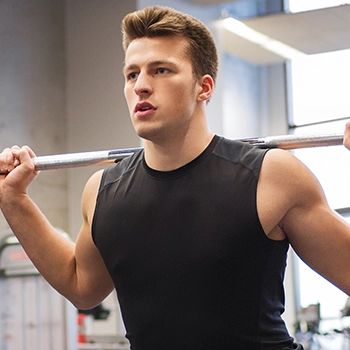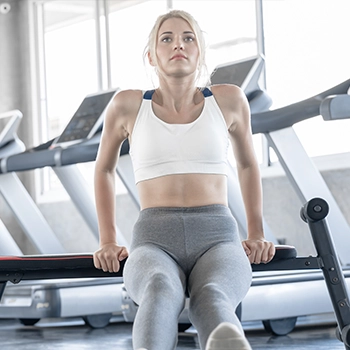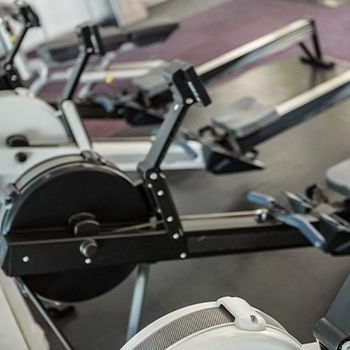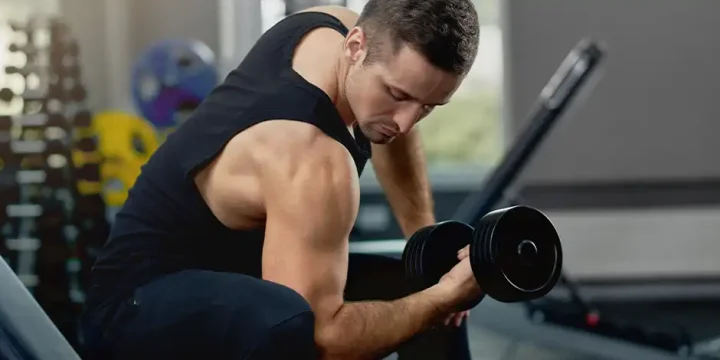The shoulder is a complex joint made from three bones: the humerus, scapula, and clavicle.
All three bones work together to create motion at the shoulder joint, but their functions aren’t always the same.
After 20 hours of research and careful consideration, I identified the worst shoulder joint exercises according to injury risk criteria.
Both multi- and single-joint exercises were considered during the testing process.
Read below to learn the worst shoulder exercises, why they are so bad for the shoulders, and what alternatives to consider.
Quick Summary
- Some of the worst shoulder exercises include lateral raises with the palm down, behind-the-shoulder presses, upright shoulder rows, triceps bench dips, and single-arm rows.
- The best way to avoid rotator cuff shoulder injury is to use free weights since they allow a bigger range of motion and don’t fix the shoulder joint.
- The National Institute of Health notes that balancing pushing and pulling exercises can equalize internal and external rotation, helping prevent shoulder tendonitis.
- In my opinion, understanding the mechanics of each exercise and its impact on the shoulder joint is key to a safe and effective shoulder workout.
Top 5 Worst Shoulder Exercises

Me and my team reviewed all the shoulder exercises before placing them on the list.
We ensured that the exercises below are the worst for the entire shoulder joint, including ligaments, bones, and surrounding muscles.
In addition, the exercises below are likely to lead to injury if you use them extensively.
I suggest completely removing them from the workout or doing alternative lifts.
"The most common problems come from repeating the same movement over and over again, and from too much arm motion above your head (like painting or hanging curtains). But your shoulder can get hurt in other ways too."
- Tyler Wheeler, Primary Care Sports Medicine Physician at Family Practice Center Atlanta
1. Lateral Raises With Palm Down or Thumb Down
Lateral raises with palms down aren't the best for building lateral deltoid muscles.
This is because the functional and anatomical movement of the shoulder in the frontal plane doesn't include internal or external shoulder rotation.
However, when you place your palms or thumbs down, your shoulders will internally rotate and cause an unnatural position, which may lead to potential injuries.
The best way to avoid injury from lateral raises is to perform them in anatomical and natural shoulder positions.
This entails no internal or external shoulder rotation while abducting your upper arm to 90 degrees.
To test when your shoulder begins to rotate internally, you should try multiple loads and choose the one where your shoulders don't compensate for the movement with rotation.
Read More: Cable Lateral Raise Guide
2. Behind the Head Shoulder Press

Behind-the-head shoulder press represents a problem for your shoulder’s health since it places extensive stretch and force while your shoulders are externally rotated.
External shoulder rotation will stretch the entire shoulder's muscle complex, which can lead to strains or even ligament issues.
To avoid the negatives of the head-shoulder press, you should do the alternative, which is the dumbbell over the head press.
The dumbbell overhead press will place your shoulder in an anatomical position and allow a greater range of motion in the joint.
3. Shoulder Upright Rows
Shoulder upright rows aren’t necessarily bad but can cause pain in the joint due to the movement being completed in an unnatural position.
Upright rows place the weight in front of your body, meaning your shoulder must abduct more than 90 degrees while your elbows remain flexed.
Perform decline or low cable rows towards your chin to avoid injuring yourself.
This will have the same results as the upright row but lower the risk of potential injury while targeting the same muscles.
Related Articles:
4. Triceps Bench Dips

Triceps bench dips are one of the easiest triceps exercises and are almost always performed in large volumes.
However, the body's range of motion and front position limit the shoulder’s range and place it in a stretched position.
You can replace bench dips with regular parallel bar dips to avoid injuring your shoulder.
Performing dips with your body weight will be enough initially, but you can progress by adding weight plates or any form of external resistance.
5. Single Arm Rows
Single-arm rows are only dangerous if you perform them incorrectly.
This means that learning the proper technique can make these exercises as efficient as the rest of the shoulder exercises.
To perform the movement correctly, you must assume an athletic stance, inhale, brace your core, and row the cable toward your hips.
You can also row the cable or resistance band towards your lower ribs to target trapezius muscles more.
Is the Rowing Machine Bad for the Rotator Cuff?

The rowing machine might harm the rotator cuff if you don't work out the whole shoulder. It's crucial to train all three shoulder heads — anterior, lateral, and posterior deltoid — and do enough internal and external rotations for muscle balance.
Remember, while the deltoids are key, the rotator cuff muscles and shoulder blades enable rotation and additional movement in various exercises.
According to the National Institute of Health (NIH), shoulder injuries or rotator cuff injuries occur when your internal shoulder rotation is much stronger than your external shoulder rotation [1].
According to the NIH, performing the same amount of pushing and pulling exercises can balance out the external and internal rotation and avoid shoulder tendonitis [2].
Are Push-Ups a Bad Exercise for Shoulders?

No, push-ups aren’t a bad exercise for the shoulders. Shoulder pain from push-ups may occur if your external rotators or back muscles are weak, meaning your pectoral muscle is shortened.
Push-ups trump flat bench presses as they engage more rotator cuff muscles, thanks to the shoulder blades' movement, reducing shoulder pain.
Caleb Gray from Click Physiotherapy notes they're safer for unstable shoulders with hands grounded, activating more stabilizers.
But be careful with existing shoulder injuries, as push-ups can strain these muscles. For pain-free push-ups, go wider than shoulder-width, keeping your hands at 30 degrees internally rotated, 45 degrees flexed, and 60 degrees abducted.
Learn More: Best Exercises and Stretches for Shoulder Pain Relief
Is Shoulder Press or Military Press Bad for the Shoulders?
No, shoulder press or military press isn’t bad for the shoulders. Overhead press exercises are excellent for strengthening your deltoid and rotator cuffs.
If you feel shoulder pain while doing barbell pressing, try switching to dumbbell overhead presses instead.
Alternatives to Traditional Shoulder Exercises
For individuals with shoulder injuries, traditional exercises can be risky. Here are four safer alternatives:
- Seated Dumbbell Press: Instead of the standing barbell press, try the seated dumbbell press. This exercise reduces the strain on the shoulder joint by allowing a more natural movement. Use lighter weights and focus on controlled movements.
- Cable Face Pulls: This exercise targets the rear deltoids and rotator cuff muscles without the high risk of injury associated with overhead presses. It's excellent for improving shoulder stability and posture.
- Resistance Band Lateral Raises: These are a low-impact alternative to dumbbell lateral raises. The resistance band provides a more joint-friendly tension, reducing the risk of exacerbating shoulder injuries.
- Aquatic Exercises: Performing shoulder exercises in water can significantly reduce joint stress. Movements like arm circles, shoulder abduction, and flexion in a pool offer resistance due to water's natural viscosity, making them effective yet gentle on injured shoulders.
FAQs
What Are the Worst Exercises for Rotator Cuff?
The worst exercises for rotator cuff include behind-the-head overhead barbell presses, triceps bench dips, and lateral raises with internal rotation.
What Gym Exercises to Avoid With Bad Shoulder?
Gym exercises to avoid with a bad shoulder include excessive internal rotation, shoulder abducting as chest flies, and excessive shoulder extension.
Are Skull Crushers Bad for Shoulders?
No, skull crushers aren’t bad for shoulders. However, you must fixate on the shoulder joint and only perform the movement in the elbow joint during the whole exercise.
References:
- https://www.ncbi.nlm.nih.gov/books/NBK547664/
- https://www.ncbi.nlm.nih.gov/pmc/articles/PMC9378805/
About The Author
You May Also Like






